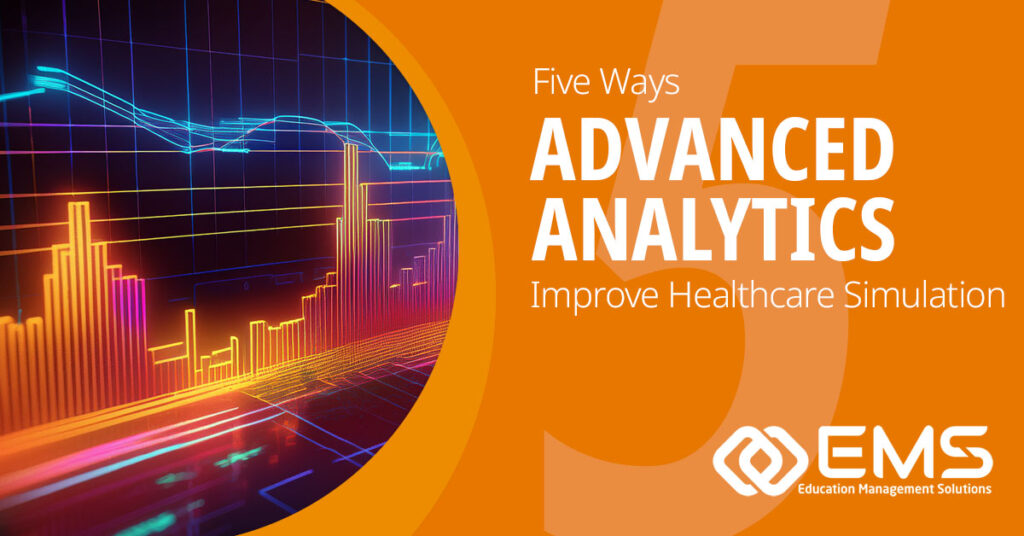In recent years, leveraging advanced analytics within healthcare simulation training curriculums has become a strategic imperative for educators looking to enhance their training programs and improve learning. Properly collected and interpreted data-driven insights can truly transform how simulationists optimize learning outcomes, reduce training costs, and ensure student preparedness for real-world scenarios.
This article will explore five significant ways advanced analytics are reshaping healthcare simulation, driving efficiency, improving decision-making, and fostering interprofessional collaboration.
1. Enhanced Realism and Accuracy
With information gathered and analyzed through advanced analytics, healthcare educators can create more realistic clinical scenarios by leveraging large amounts of data to find the most applicable situations that produce the most favorable results. This tailoring of scenarios results in simulations that more accurately reflect the complexities and variability of real-world medical practice, thereby better preparing healthcare professionals for diverse patient interactions and crisis situations1.
Additional sources of gatherable data can further enrich simulation experiences by enabling adaptive learning environments, providing better high-fidelity physiological responses, and offering personalized feedback loops.
2. Personalized Learning Experiences
Through the proper use of advanced data analytics, simulation educators can utilize algorithms that analyze students’ actions and decisions during simulations, identifying strengths and weaknesses. With this information in hand, instructors can offer more impactful personalized guidance and create adaptive scenarios to target more individualized areas needing improvement2.
This data-driven approach can foster personalized learning by providing tailored training environments and feedback, enhancing students’ clinical decision-making skills with training that is targeted to their specific learning needs.
3. Improved Decision-Making Skills
By integrating advanced data analytics, simulation platforms can meticulously track and evaluate every aspect of a learner’s performance. This includes their decision-making speed, accuracy, adherence to clinical protocols, and response to dynamic scenarios. By analyzing these data points, educators can identify specific areas of strength and those requiring improvement for each student. This granular level of detail allows for highly relevant and instantaneous feedback, enabling students to understand and rectify their mistakes in real time, which is critical for developing competent, confident healthcare professionals3.
Additionally, harnessing these analytics optimizes training programs, offering institutions a powerful tool to improve educational outcomes while managing costs effectively. The insights gained through data analysis allow for the customization of simulation scenarios to address common gaps in knowledge and skills, ensuring that training is both relevant and challenging. This leads to more efficient use of training resources, as educators can focus on critical areas that yield the highest ROI.
4. Enhanced Interprofessional Collaboration
Big data plays a pivotal role in dismantling professional silos within healthcare and educational institutions by fostering seamless communication and collaboration among diverse teams. Through advanced simulation management platforms, educators and trainers can harness the power of aggregate information to integrate comprehensive performance metrics, real-time feedback, and detailed analytics. This integration ensures that all relevant stakeholders—ranging from students and educators to healthcare professionals—have access to consistent, accurate, and actionable data4.
Additionally, by analyzing extensive datasets from various disciplines, participants in interprofessional training can establish shared understanding of overarching goals and performance standards.
5. Optimized Resource Allocation
Advanced collection and interpretation of data in healthcare simulation can also extend to optimizing resource allocation and operational efficiency for sim centers. Predictive analytics within simulation management platforms can anticipate learner needs, manage training schedules, and streamline administrative tasks, ultimately reducing costs and enhancing the overall training experience5.
By leveraging these technologies, institutions can ensure comprehensive training support for their staff and students, aligned with the latest medical standards and practices.
Big Data, Better Outcomes
The integration of advanced analytics into healthcare simulation represents a transformative approach to training, offering unparalleled insights and actionable data that drive significant improvements in clinical practice. From enhancing decision-making skills to providing personalized feedback and fostering interprofessional collaboration, these sophisticated analytical tools elevate the quality and efficiency of healthcare education.
By harnessing the power of big data, institutions can ensure their training programs are both cost-effective and outcome-focused, ultimately leading to better-prepared healthcare professionals and improved patient care.
Discover how EMS can help you optimize your simulation data analysis and achieve superior training results without overextending your budget. Contact us today to learn more.
Footnotes
- https://bmcmededuc.biomedcentral.com/articles/10.1186/s12909-024-05916-y
- https://www.nursingsimulation.org/article/S1876-1399(23)00070-1/fulltext
- https://pmc.ncbi.nlm.nih.gov/articles/PMC11702416/
- https://pmc.ncbi.nlm.nih.gov/articles/PMC11360843/
- https://advancesinsimulation.biomedcentral.com/articles/10.1186/s41077-024-00288-1

